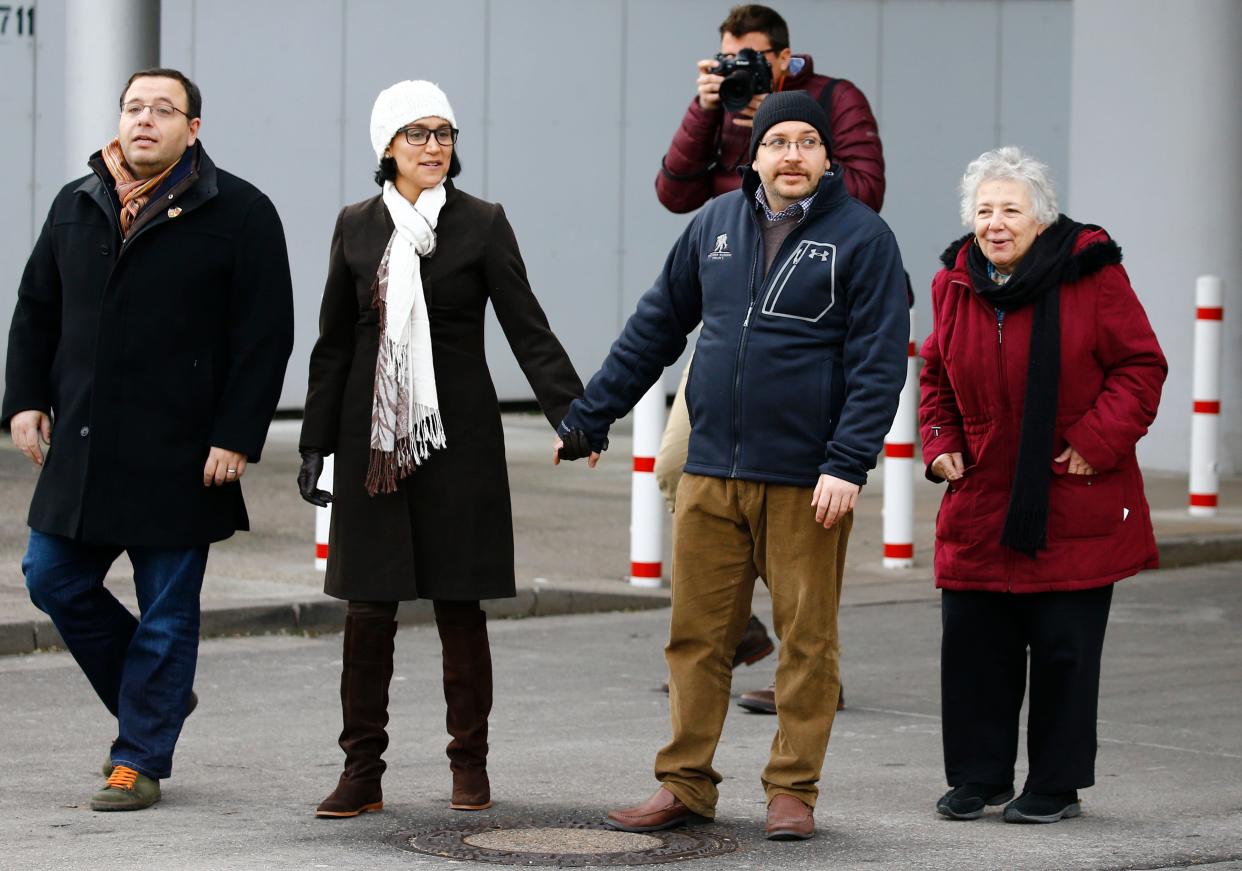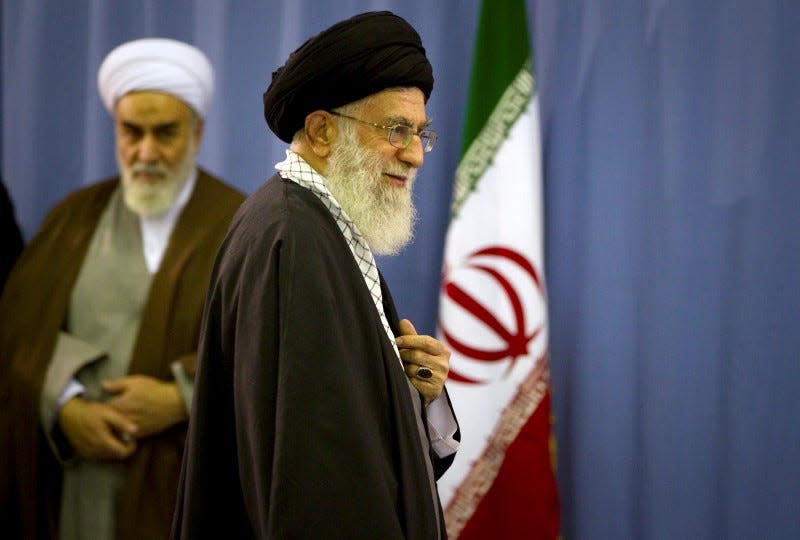Here's what we know about what might have happened to the longest-held hostage in US history

On January 16, the US secured the release of five American citizens who were, in the words of President Barack Obama, "unjustly detained" in Iran.
Their freedom came at a steep price: The US pardoned or dropped charges against seven Iranian citizens accused of violating US sanctions against the country, effectively swapping criminals for hostages.
The US dropped all charges against 14 additional regime-linked figures, including the CEO of Mahan Air, a state-owned airline accused of ferrying arms and fighters to the regime of Bashar al-Assad in Syria. An Iranian general has also claimed that the US made a $1.7 billion direct payment to the Iranian government on debts stemming from the 1979 break in diplomatic relations as a condition for the prisoners' freedom.
Even this wasn't enough to secure the release of two other Americans still held in Iran: Siamak Namazi, an oil executive and longtime proponent of closer relations between the US and Iran who was arrested in Tehran in October, and Robert Levinson, a security consultant, former FBI agent, and CIA contractor who disappeared on the island of Kish, in the Persian Gulf, on March 9, 2007.
In 2013, Levinson became the longest-held hostage in American history, passing Associated Press correspondent Terry Anderson, who was held by Lebanese Hezbollah during the 1980s.
Levinson's situation is thorny — for both countries. Levinson — a longtime veteran of the FBI's money laundering division and specialist on Russian organized crime — was doing work for the agency that fell outside the scope of the analytics division that had him under contract, as a 2013 New York Times report uncovered. The CIA's Illicit Finance Group was using Levinson for freelance source recruitment and information gathering.
The Times reported that Levinson informed his CIA bosses that he intended on going to Kish. At the time, Levinson was in Dubai investigating cigarette smuggling in the Persian Gulf region on behalf of a private client. And although CIA investigators never firmly established that Levinson was traveling on agency business, the episode cost three CIA officials their jobs, according to the Times.
The failure to free Levinson under the January 16 deal owes in part to the Iranian government's claims that he isn't in their custody. That might technically be true. But the best public explanation of what happened to him suggests the Iranian government was responsible for his capture.

APIn December of 2013, shortly after the Associated Press and The New York Times published the details of Levinson's CIA affiliation, Time Magazine published an interview with Dawud Salahuddin, the person Levinson planned on meeting in Kish. Salahuddin was born in New York and converted to Islam as a young adult. He fled the US in 1980 after assassinating Ali Akbar Tabatabaei, an Iranian dissident and a former diplomat under the deposed Shah on Iran, in Potomac, Maryland.
Salahuddin is an almost unique figure in the Middle East: A fluent English speaker who has killed on behalf of the Iranian regime and has a deep knowledge of Iran's government and society — as well as a certain exhaustion towards a country where he's been stuck for the past 36 years. A former employee of Iran's state-owned Press TV, he is both well-connected and somewhat free to speak and travel within Iran. (Salahuddin also had one of the leading roles in "Kandahar," Mohsen Makhmalbaf's acclaimed 2001 film about a woman's search for her sister in Taliban-ruled Afghanistan).
Levinson must have realized that Salahuddin made an ideal intelligence source. But due to Salahuddin's high profile, American citizenship and links to the regime, he was an asset who ran the risk of attracting the wrong kind of attention. And as The New York Times report noted, Levinson had no experience working in Iran and little knowledge of the country.

AP
According to the Times, Levinson was put in touch with Salahuddin through Ira Silverman, a retired NBC News producer who knew Levinson during his FBI days, and had profiled Salahuddin for The New Yorker in 2002.
Salahuddin told Time he agreed to meet Levinson after speaking with him on the phone three times. They met at Kish's Maryam Hotel, "where Levinson had booked them into the same room — a fatal error, Salahuddin came to realize." According to Time, "The presence of two Americans drew the attention of the Interior Ministry, whose officials routinely check hotel registrations. Both men were detained by ministry officials; Salahuddin spent the night in jail, and never saw Levinson again."
In the Time interview, Salahuddin denied he knew Levinson was attempting to recruit him as a CIA source. He also pushed back against the insinuation that Iranian intelligence services had used him as bait for Levinson.
"The notion that it was some kind of brilliant move on the part of Iranian intelligence is bull---t," Salahuddin told Time. "It was dumb luck. I've been around these guys long enough to know when they're on to something and when they get lucky. And those guys were lucky." In context, Salahuddin's "those guys" refers to security officials connected to Iran's Interior Ministry.
See photos from the case:
Salahuddin has plenty of reason not to be entirely truthful about his meeting with Levinson. As Salahuddin told Time, "over the years I have lost a lot of respect for the Iranian system ... It relies on blunt force. Iranians are afraid of their government. The basis of their rule is not love and respect for their rulers, it's fear." He met with Levinson's family in Iran in 2007 and might have been looking for a way out of the country — an objective that would become a lot more complicated if it ever turned out he knowingly lured a US intelligence contractor into a state-sponsored kidnapping.
Regardless of his motives, Salahuddin told Time that he was kept in Interior Ministry custody the night he met Levinson. It's reasonable to assume the Iranian state held Levinson as well, at least at the outset of his captivity.
What exactly happened to Levinson after that? As late as 2012, then-Iranian president Mahmoud Ahmadinejad made what experts interpreted as a "tacit admission" that Levinson was in Iranian state custody. The fact that the Iranian government claims it can no longer account for Levinson's whereabouts suggests that he's either considered too important of a prisoner to release even as a gesture of cooperating or goodwill, or that he was transferred at some point to a paramilitary group with ties to the Iranian regime.
The latter possibility seems the more likely of the two. Shortly after the swap, high-ranking US Middle East diplomat Brett McGurk told PBS that the US suspects Levinson is no longer being held in Iran.

AP
Levinson's disappearance highlights an uncomfortable reality about the nature of the Iranian regime.
The Iranian government is highly factionalized, consisting of a national security and intelligence elite that often acts independently of the country's political leadership.
The relationship between the regime's various centers of power is never entirely clear, and this uncertainty gives the regime's most dangerous elements an alarming degree of freedom. It's not obvious how much control Iran's current president, Hassan Rouhani, has over Qassem Soleimani, the head of Iran's elite special forces unit, the Qods Force. However, it's clear Suleimani has broad ability to aid and coordinate Shiite militia groups throughout Lebanon, Iraq, and Syria.
Iran's boosting of militants and terrorist groups is enabled partly through the regime's compartmentalization. Iran doesn't just have external proxy groups that act as an extension of the regime's policy, or at least the preferred policies of certain regime elements. There are also government-supported paramilitaries acting within the country as well — entities like the Basij militia.
The dangers of the regime's closeness to militia groups was on display when Iran-linked militants in Baghdad kidnapped three American contractors earlier this month.
America's recent nuclear deal with Iran might have built unprecedented degrees of trust and confidence between the countries, reframing and de-escalating their relationship for decades to come. But as Levinson's ordeal and the kidnapping in Baghdad each demonstrate, the thaw hasn't changed the composition of the Iranian regime, or dissuaded it from stopping some of its most provocative behavior.
NOW WATCH: Steven Avery's defense attorney admits doubts about his innocence
See Also:
Last Man To See CIA-Asset Robert Levinson Alive Says Iran Definitely Got Him
American Missing Nearly 7 Years In Iran Was On An Unapproved CIA Mission
SEE ALSO: GATES: Don't expect the nuclear agreement to lead to a more moderate Iran
